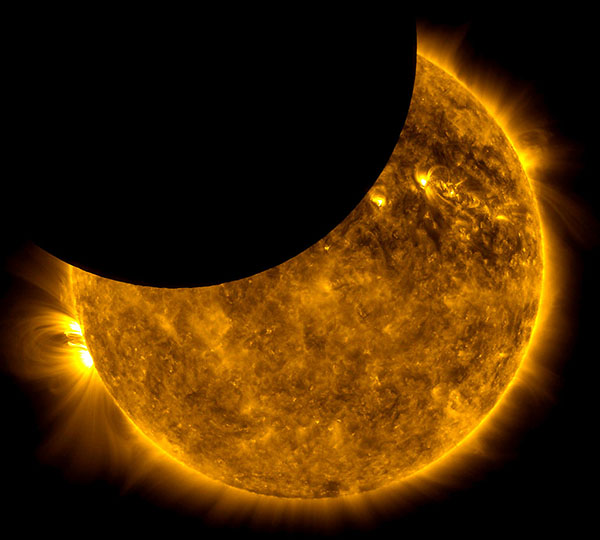
by Alex Kasprak Sunday, October 14, 2012

The moon passes in front of the sun. New research suggests solar wind may be responsible for water on the moon. NASA
Until recently, the consensus in the scientific community was that the moon was bone-dry. Scientists thought that the massive impact responsible for the moon’s creation would have driven away the hydrogen needed to form water. In the past four years, however, that view has melted away. The first suggestion of water was in 2008, when researchers identified the presence of water in volcanic lunar glass. In 2009, satellites orbiting high above the moon identified water on its surface. Also in 2009, in a moment of spectacular showmanship, NASA crashed a spacecraft into the south pole of the moon, liberating large quantities of water from ice. Determining the source of lunar water is the new frontier. Now, new research on microscopic grains of lunar glass suggests that much of the lunar surface is rich with water, and that the water comes from the sun.
Yang Liu, a geologist at the University of Tennessee, and colleagues, suggest in Nature Geoscience that a significant amount of water on the surface of the moon comes from the constant bombardment of hydrogen ions ejected from the sun. The sun is continuously shedding its mass by ejecting these ions into space, creating what is termed solar wind. Solar wind is one of three mechanisms scientists have suggested as possible sources of lunar water — the other two being the impact of icy comets and lunar volcanism. The hydrogen that makes up solar wind hits the moon with enough force to bind with oxygen, making it conceivable that solar wind could produce water.
To test the idea, Liu and her team first had to find water in lunar soil. She focused her attention on tiny particles called agglutinates. These microscopic grains of lunar dust form when micro-meteorites impact the surface of the moon, where they create glass-like particles through melt. By documenting what wavelengths of light were absorbed in these tiny grains, Liu identified what elements were contained within.
Many of the grains contained hydroxyl, the form that water takes when it is locked in a solid, indicating that the surface lunar soil, which is rich in agglutinates, contained significant amounts of water. “It has been long suspected [that there] is water in agglutinates,” Liu says, but “we haven’t been able to identify it until now.”\
Finding water was only half the battle, Liu says. To determine where the water came from, the team measured the amount of deuterium, a heavier isotope of hydrogen, in the samples. Because the sun is too hot to support deuterium, there isn’t any of it in solar wind. But hydrogen from other potential sources has plenty of deuterium, so its absence is indicative of a solar origin. Liu and her colleagues found almost no deuterium. “The majority of the hydroxyl we saw is solar wind derived,” she says.
Deuterium values as low as Liu’s are “only consistent with solar wind implantation,” says James Greenwood, a planetary geologist at Wesleyan University, though he points out that there are still other reservoirs of water on the moon.\
Because agglutinates make up a large portion of lunar soil, demonstrating that hydroxyl might occur so frequently within them could have ramifications for the future of space exploration, Liu says. The moon has long been discussed as a potential base for future space exploration. If water — which can be converted into fuel — were found in abundance, it could power future missions.
For now though, Liu is excited about the broader implications. Recognizing the role of solar wind, she says, “gives us hope [for] finding water in other areas [of the solar system].”
© 2008-2021. All rights reserved. Any copying, redistribution or retransmission of any of the contents of this service without the expressed written permission of the American Geosciences Institute is expressly prohibited. Click here for all copyright requests.